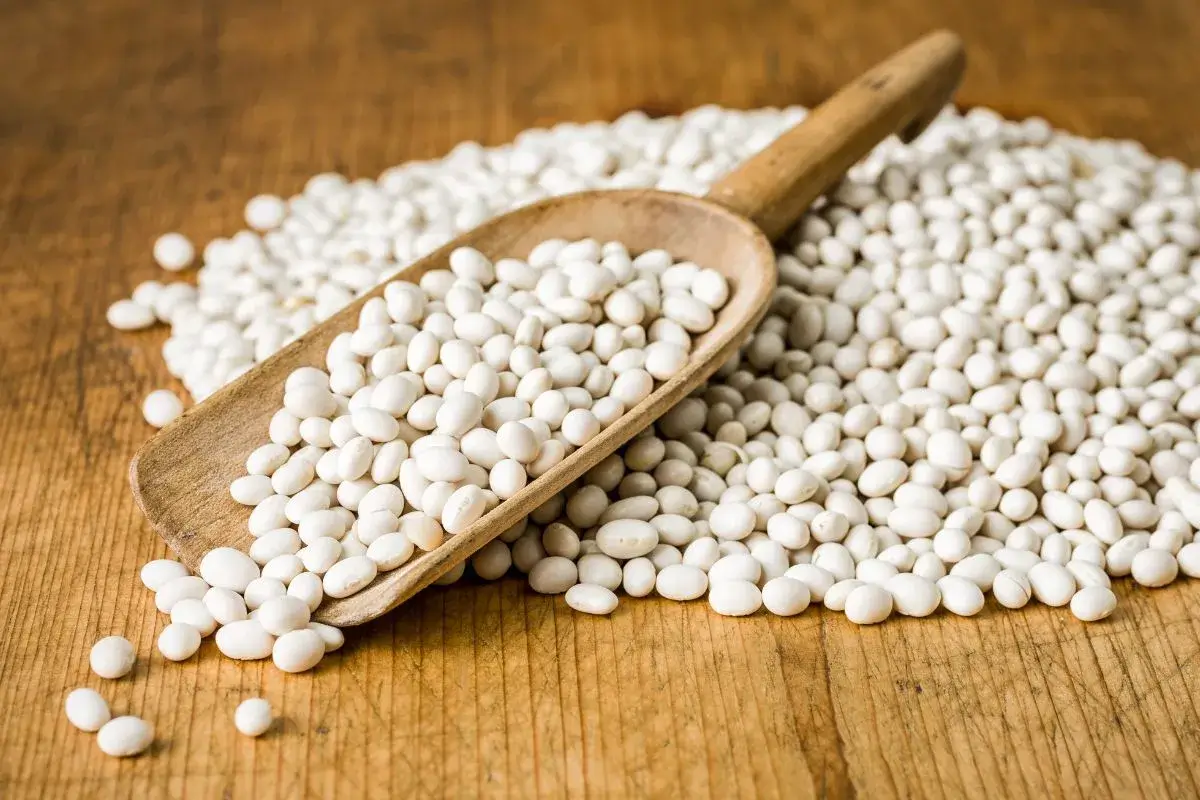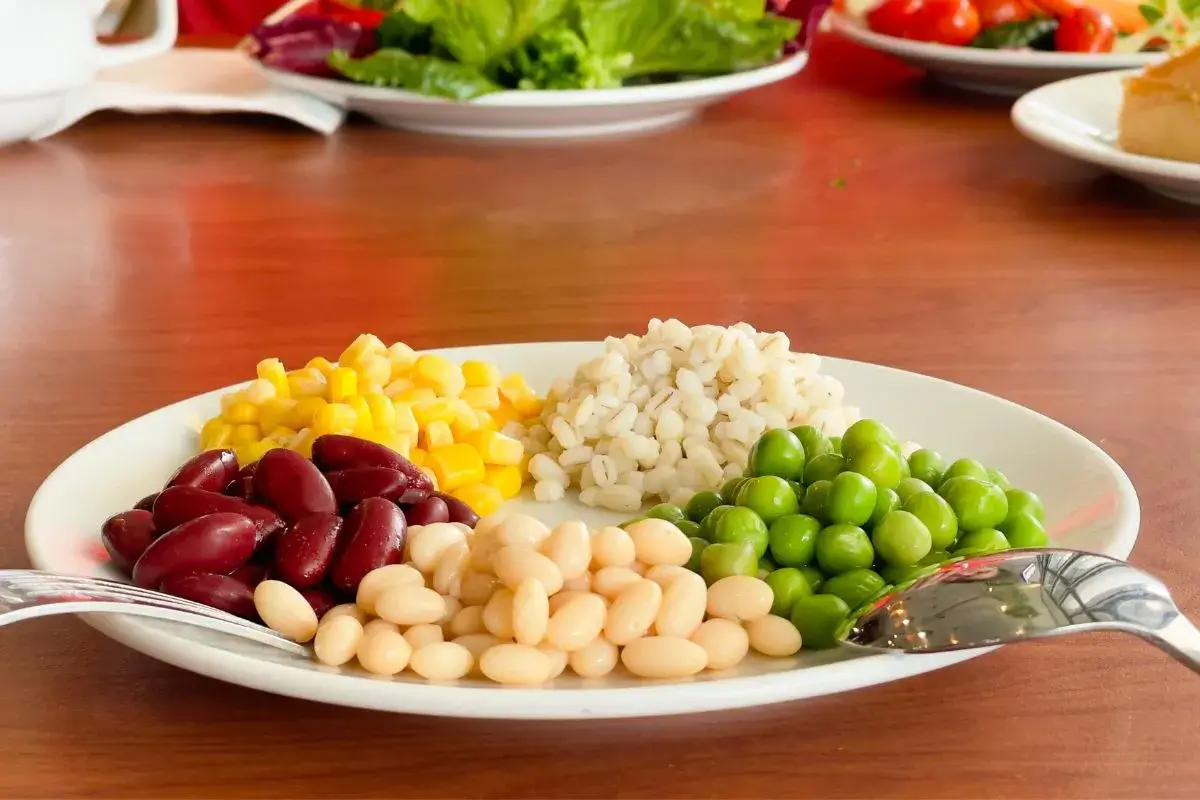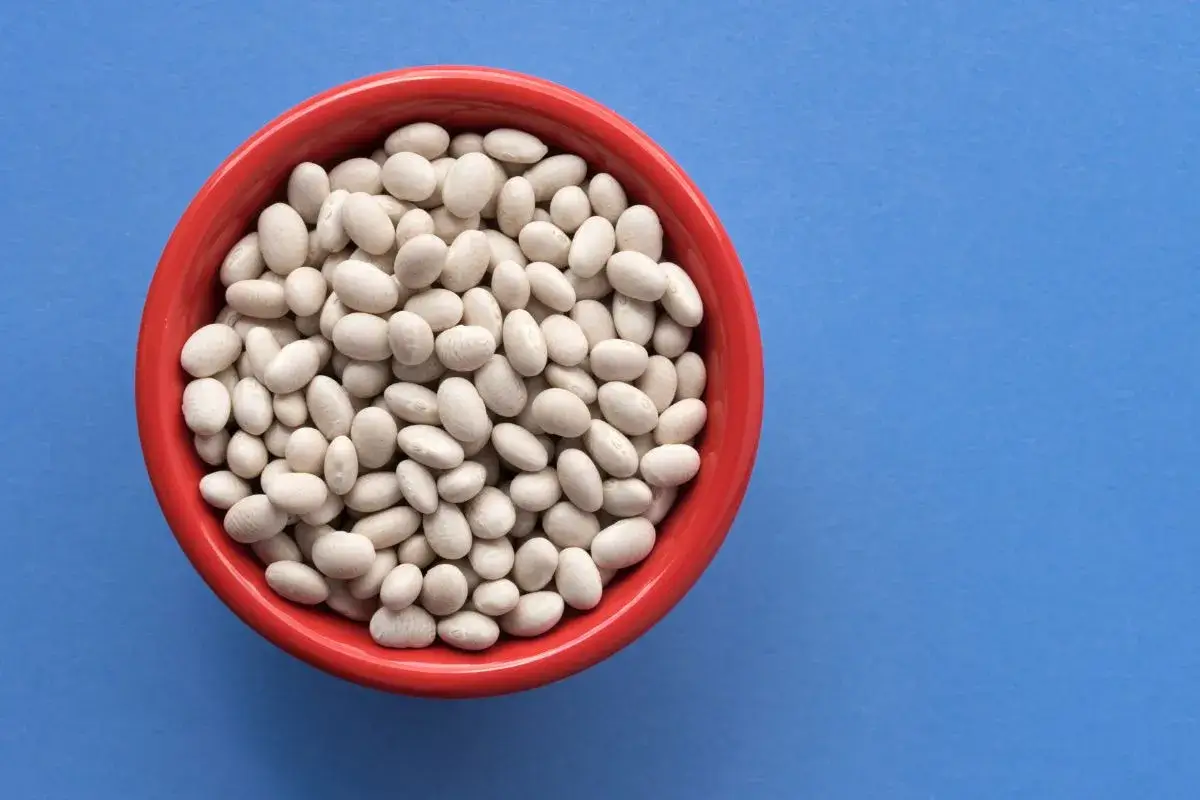Navy beans, those small yet mighty legumes, have woven their way into culinary traditions worldwide. They’re not just packed with nutrition but also offer unmatched versatility. From America’s heart to the Mediterranean coasts, they’re a kitchen staple. Our deep dive will explore everything about navy beans. We’ll look into their name origin, uses, cooking secrets, and the best substitutes. By the end, you might just find these beans appearing in your meals more often than expected!
Overview of Navy Beans
Meet the humble navy bean! It’s small but enormous in nutritional value and historical significance. This bean has powered nations, fed sailors on long voyages, and become a key ingredient in iconic dishes like navy bean soup. But what are these beans, and how did they carve their niche in the legume world?
Navy beans, or haricot beans, are a common bean variety (Phaseolus vulgaris) loved for their mild flavor and creamy texture. They’re culinary chameleons, absorbing the flavors of their cooking companions, making them perfect for a wide range of dishes. Loaded with protein, fiber, and essential nutrients like magnesium and potassium, they’re a nutritional powerhouse.
A Brief History and Origin
The history books tell us that navy beans got their name from their crucial role in the U.S. Navy in the early 20th century. They became essential for sailors because of their long shelf life and dense nutrition, vital for long sea journeys. However, their history starts even earlier. Indigenous peoples in the Americas cultivated these beans long before Columbus’s voyages.
So, why focus on these beans? Beyond their intriguing history, they inspire culinary creativity, offer health benefits, and bring centuries-old traditions to our plates. Join us as we explore the navy bean world, where each bean tells a story, and every dish shares a piece of history. Stay tuned as we dive deeper into their naming, uses, and how to cook them perfectly.
The Name Origin
Why are Navy Beans Called Navy Beans?
Ever wondered how those little legumes got the name “navy beans”? Well, it takes us back to a time when these beans served as more than just food; they were a lifeline. The term “navy bean” anchors itself in maritime history, reflecting its crucial role in the U.S. Navy.
Back in the day, sailors embraced navy beans as a dietary staple. Thanks to their compact size, lengthy shelf life, and nutritional value, these beans suited long sea voyages perfectly. Picture yourself on a wooden ship, months away from the nearest port, with no refrigerator in sight. You’d need food that wouldn’t spoil and could keep you nourished. Navy beans rose to the challenge, offering essential calories, protein, and nutrients. They kept sailors hearty and well-fed during their extended journeys across the oceans.
However, these beans didn’t just find their way onto naval ships by chance. Indigenous peoples in the Americas had been cultivating them long before European explorers embarked on their voyages. The U.S. Navy’s extensive use of navy beans simply solidified their name in the annals of history.
So, the next time you savor a dish with navy beans, remember, you’re not just enjoying a simple bean. You’re connecting with a piece of maritime history, a testament to exploration and endurance on the high seas. Isn’t it fascinating how a humble bean can embody such a rich narrative and link to our past? Stick around as we delve further into the versatile world of navy beans, from time-honored recipes to contemporary culinary creations.
Uses and Benefits
What are Navy Beans Used For?
Now, let’s dive into the versatile world of navy beans and discover their myriad uses and benefits. These beans are not just a key ingredient in the classic navy bean soup; they’re a culinary treasure trove waiting to be explored. So, why are they so popular in kitchens around the globe?
First off, navy beans are culinary chameleons. They seamlessly blend into a variety of dishes, from hearty stews and soups to refreshing salads and savory side dishes. Their mild flavor and creamy texture make them an ideal canvas for a spectrum of flavors, absorbing and complementing the tastes they’re cooked with.
But there’s more to these beans than meets the palate. Packed with protein, they’re a fantastic plant-based protein source, making them a staple in vegetarian and vegan diets. They’re also rich in dietary fiber, which is essential for digestive health, and they offer a good dose of essential nutrients like magnesium and potassium. These nutrients play vital roles in our body, supporting heart health, muscle function, and more.
Moreover, they have a low glycemic index, making them an excellent choice for people managing diabetes. They help regulate blood sugar levels, providing a steady source of energy without the spikes associated with other carbohydrate-rich foods.
Nutritional Benefits and Health Implications
The health benefits of navy beans extend even further. Regularly incorporating them into your diet can contribute to reduced risk of chronic diseases such as heart disease and diabetes. The fiber content not only aids digestion but also helps in lowering cholesterol levels. Plus, their antioxidant properties combat oxidative stress and inflammation, contributing to overall health and well-being.
In addition, navy beans are a gluten-free ingredient, making them a fantastic option for those with gluten sensitivities or celiac disease. They offer a way to enrich your diet with valuable nutrients without the worry of gluten.
In summary, navy beans are a versatile, nutritious, and delicious addition to any meal. Their uses stretch far beyond the traditional recipes, inviting culinary exploration and innovation. From their role in improving health to their ability to adapt to various culinary styles.
Culinary Journey
How to Cook Navy Beans

Cooking navy beans is a journey in itself, a process that transforms these modest legumes into a delicious, nutritious component of countless dishes. Whether you’re a seasoned chef or a home cook, mastering the art of cooking navy beans can elevate your culinary creations. So, how do you cook navy beans to perfection? Let’s break it down.
Soaking and Preparation
Before anything else, soaking the beans is key. This crucial step softens them, reduces cooking time, and makes them easier to digest. You have two main options: the overnight soak and the quick soak. The overnight soak involves leaving the beans in a large bowl of cold water for at least 8 hours. If you’re short on time, the quick soak method comes to the rescue. Simply boil the beans in water for a minute, then let them soak for an hour off the heat.
After soaking, drain and rinse the beans, then they’re ready for cooking.
Cooking Methods
- Stovetop: Place the soaked beans in a pot, cover with fresh water, and bring to a boil. Then, reduce the heat and simmer gently until the beans are tender, which usually takes about 1 to 2 hours. Keep an eye on the water level and add more as needed to keep the beans submerged.
- Slow Cooker: For those who love set-and-forget cooking, the slow cooker is your friend. After soaking, place the beans in the cooker, add water, and cook on low for 6 to 8 hours. This method is ideal for achieving perfectly tender beans with minimal effort.
- Pressure Cooker: If you’re in a rush, the pressure cooker significantly speeds up the process. Cook soaked beans with water at high pressure for about 20 to 30 minutes. It’s fast, efficient, and yields great results.
Seasoning and Flavor Enhancement Tips
To elevate your navy beans, consider adding aromatics like onion, garlic, herbs, and spices during the cooking process. These ingredients infuse the beans with rich flavors, transforming them into a tasty base for a variety of dishes. Just remember, add salt towards the end of cooking to prevent the beans from becoming tough.
Cooking navy beans is a simple yet rewarding task, one that opens up a world of culinary possibilities. From soups and stews to salads and sides, these beans can do it all, offering a delicious way to boost your meals with nutrition and flavor.
Alternative Ingredients
Substitute for Navy Beans

Sometimes, the pantry runs dry of navy beans right when you need them. Fear not! The world of legumes is rich and varied, offering several suitable substitutes that can step in without missing a beat. Let’s explore the top alternatives to navy beans that keep your culinary projects on track.
- Great Northern Beans: These are a fantastic substitute due to their similar mild flavor and firm texture. Great Northern beans work well in recipes that call for navy beans, such as soups and stews, seamlessly blending into the dish’s overall flavor profile.
- Cannellini Beans: Known for their larger size and creamier texture, cannellini beans are another excellent alternative. They’re particularly great in dishes where a more robust bean presence is welcome, adding a touch of creaminess without overwhelming the other ingredients.
- Pinto Beans: While their flavor is slightly nuttier, pinto beans can serve as a stand-in for navy beans in many recipes. They’re especially good in Mexican and Southwestern dishes, where their earthy taste complements the bold flavors.
- Black-Eyed Peas: For a slightly different but equally delightful option, black-eyed peas can substitute navy beans in soups and salads. They bring a unique, slightly sweet flavor that can add an interesting twist to traditional recipes.
When to Substitute in Recipes
While these substitutes can fill in for navy beans, it’s essential to consider the dish’s flavor profile and texture. In general, these alternatives work well in recipes where beans are not the sole star of the show but part of a broader ensemble of ingredients. Adjust cooking times as needed, as different beans may require shorter or longer periods to reach the desired tenderness.
Incorporating these substitutes into your cooking not only saves a meal in a pinch but also introduces you to the broad spectrum of flavors and textures that other legumes offer. Experimenting with these alternatives can lead to delightful culinary discoveries and might just inspire your next favorite dish.
In summary, running out of navy beans isn’t a culinary dead-end but an opportunity to explore the diverse world of legumes. Each substitute brings its unique taste and texture to the table, ensuring your dishes remain delicious and satisfying. Up next, we’ll answer some frequently asked questions, shedding light on common curiosities and offering tips to enhance your bean experience.
FAQs
Diving into the world of navy beans often brings up a bundle of questions. From their preparation to storage, there’s a lot to uncover. Let’s address some frequently asked questions that might have crossed your mind.
1. Can I cook navy beans without soaking?
Yes, you can, but soaking them beforehand reduces cooking time and makes them easier to digest. If you’re pressed for time, use the quick soak method or simply increase the cooking time if you prefer not to soak them.
2. How long do cooked navy beans last in the fridge?
Cooked, they will last in the refrigerator for about 3 to 5 days. Ensure they’re stored in an airtight container to maintain freshness. For longer storage, consider freezing them.
3. Are navy beans and great northern beans the same?
While they’re both white beans, they’re not the same. Navy beans are smaller and denser with a mild flavor, whereas Great Northern beans are larger and have a slightly nuttier taste. They can substitute for each other in many recipes, though.
4. Can navy beans help with weight loss?
Yes, navy beans can be a great addition to a weight loss diet. They’re high in protein and fiber, which can help you feel full and satisfied, reducing overall calorie intake. Plus, their low glycemic index means they provide sustained energy without spiking your blood sugar.
5. How can I make my navy beans more flavorful?
To boost the flavor of navy beans, cook them with aromatics like onions, garlic, and herbs. Adding a piece of smoked meat or a splash of olive oil can also enhance their taste. Experiment with spices and herbs to find the combination that tickles your taste buds.
6. Do I need to adjust the cooking time for navy beans in high altitudes?
Yes, cooking times for navy beans can increase at higher altitudes due to lower boiling points. Expect to add more water and extend the cooking time. Keep an eye on the beans and test for doneness periodically.
7. Are navy beans gluten-free?
Absolutely! They are naturally gluten-free, making them a safe and nutritious choice for those with celiac disease or gluten sensitivity.
Wrapping up!
As we wrap up our comprehensive journey into the world of navy beans, it’s clear these legumes are more than just an ingredient; they’re a staple of nutritional value, versatility, and rich history. From their role in sustaining sailors on long voyages to becoming a key component in cuisines around the world.. Whether you’re looking to explore other beans health benefits further in a “Health Benefits Butter Beans Nutritional Guide”, delve into the differences and similarities with other beans in “Butter Beans vs. Lima Beans Guide”, or discover new ways to incorporate them into your meals with our “Butter Beans Recipes Guide”, there’s always more to learn and taste.

